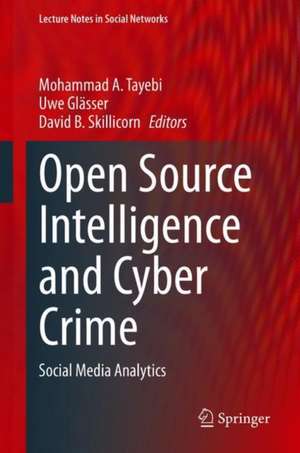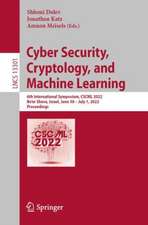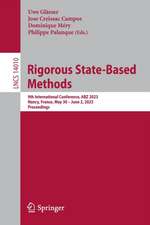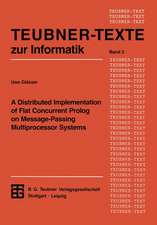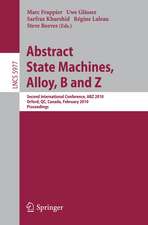Open Source Intelligence and Cyber Crime: Social Media Analytics: Lecture Notes in Social Networks
Editat de Mohammad A. Tayebi, Uwe Glässer, David B. Skillicornen Limba Engleză Hardback – aug 2020
Chapter Automated Text Analysis for Intelligence Purposes: A Psychological Operations Case Study is available open access under a Creative Commons Attribution 4.0 International License via link.springer.com.
| Toate formatele și edițiile | Preț | Express |
|---|---|---|
| Paperback (1) | 529.78 lei 6-8 săpt. | |
| Springer International Publishing – 2 aug 2021 | 529.78 lei 6-8 săpt. | |
| Hardback (1) | 668.58 lei 3-5 săpt. | +24.35 lei 7-13 zile |
| Springer International Publishing – aug 2020 | 668.58 lei 3-5 săpt. | +24.35 lei 7-13 zile |
Din seria Lecture Notes in Social Networks
- 20%
 Preț: 655.35 lei
Preț: 655.35 lei - 20%
 Preț: 990.80 lei
Preț: 990.80 lei - 18%
 Preț: 1003.38 lei
Preț: 1003.38 lei - 18%
 Preț: 917.05 lei
Preț: 917.05 lei - 20%
 Preț: 337.52 lei
Preț: 337.52 lei - 20%
 Preț: 649.28 lei
Preț: 649.28 lei - 20%
 Preț: 996.07 lei
Preț: 996.07 lei - 15%
 Preț: 503.83 lei
Preț: 503.83 lei - 18%
 Preț: 998.66 lei
Preț: 998.66 lei - 18%
 Preț: 728.74 lei
Preț: 728.74 lei - 20%
 Preț: 991.60 lei
Preț: 991.60 lei - 18%
 Preț: 1106.00 lei
Preț: 1106.00 lei - 5%
 Preț: 349.68 lei
Preț: 349.68 lei - 20%
 Preț: 339.14 lei
Preț: 339.14 lei - 20%
 Preț: 587.60 lei
Preț: 587.60 lei - 15%
 Preț: 644.82 lei
Preț: 644.82 lei - 20%
 Preț: 628.55 lei
Preț: 628.55 lei - 15%
 Preț: 587.72 lei
Preț: 587.72 lei - 20%
 Preț: 648.44 lei
Preț: 648.44 lei - 20%
 Preț: 570.97 lei
Preț: 570.97 lei - 20%
 Preț: 642.52 lei
Preț: 642.52 lei - 20%
 Preț: 655.02 lei
Preț: 655.02 lei - 15%
 Preț: 643.34 lei
Preț: 643.34 lei - 20%
 Preț: 764.43 lei
Preț: 764.43 lei - 20%
 Preț: 649.93 lei
Preț: 649.93 lei - 20%
 Preț: 649.60 lei
Preț: 649.60 lei - 20%
 Preț: 650.08 lei
Preț: 650.08 lei - 20%
 Preț: 889.64 lei
Preț: 889.64 lei -
 Preț: 389.11 lei
Preț: 389.11 lei -
 Preț: 395.09 lei
Preț: 395.09 lei - 20%
 Preț: 649.75 lei
Preț: 649.75 lei - 20%
 Preț: 924.56 lei
Preț: 924.56 lei - 20%
 Preț: 341.95 lei
Preț: 341.95 lei - 20%
 Preț: 992.76 lei
Preț: 992.76 lei - 20%
 Preț: 934.03 lei
Preț: 934.03 lei - 15%
 Preț: 641.03 lei
Preț: 641.03 lei
Preț: 668.58 lei
Preț vechi: 835.72 lei
-20% Nou
Puncte Express: 1003
Preț estimativ în valută:
127.95€ • 133.09$ • 105.63£
127.95€ • 133.09$ • 105.63£
Carte disponibilă
Livrare economică 22 martie-05 aprilie
Livrare express 08-14 martie pentru 34.34 lei
Preluare comenzi: 021 569.72.76
Specificații
ISBN-13: 9783030412500
ISBN-10: 3030412504
Pagini: 251
Ilustrații: V, 251 p. 88 illus., 69 illus. in color.
Dimensiuni: 155 x 235 x 22 mm
Greutate: 0.54 kg
Ediția:1st ed. 2020
Editura: Springer International Publishing
Colecția Springer
Seria Lecture Notes in Social Networks
Locul publicării:Cham, Switzerland
ISBN-10: 3030412504
Pagini: 251
Ilustrații: V, 251 p. 88 illus., 69 illus. in color.
Dimensiuni: 155 x 235 x 22 mm
Greutate: 0.54 kg
Ediția:1st ed. 2020
Editura: Springer International Publishing
Colecția Springer
Seria Lecture Notes in Social Networks
Locul publicării:Cham, Switzerland
Cuprins
Chapter1. Studying the Weaponization of Social Media: Case Studies of Anti-NATO Disinformation Campaigns.- Chapter2. Cognitively-Inspired Inference for Malware Task Indentation.- Chapter3. Beyond the ‘Silk Road’: Assessing Illicit Drug Marketplaces on the Public Web.- Chapter4. Protecting the Web from Misinformation.- Chapter5. Social Media for Mental Health: Data, Methods, and Findings.- Chapter6. Twitter Bots and the Swedish Election.- Chapter7. Automated Text Analysis for Intelligence Purposes: A Psychological Operations Case Study.- Chapter8. You are Known by Your Friends: Leveraging Network Metrics for Bot Detection in Twitter.- Chapter9. Inferring Systemic Nets with Applications to Islamist Forums.
Textul de pe ultima copertă
This book shows how open source intelligence can be a powerful tool for combating crime by linking local and global patterns to help understand how criminal activities are connected. Readers will encounter the latest advances in cutting-edge data mining, machine learning and predictive analytics combined with natural language processing and social network analysis to detect, disrupt, and neutralize cyber and physical threats. Chapters contain state-of-the-art social media analytics and open source intelligence research trends. This multidisciplinary volume will appeal to students, researchers, and professionals working in the fields of open source intelligence, cyber crime and social network analytics.
Chapter Automated Text Analysis for Intelligence Purposes: A Psychological Operations Case Study is available open access under a Creative Commons Attribution 4.0 International License via link.springer.com.
Caracteristici
Includes research results with important implications for law enforcement agencies and intelligence services Provides graduate students with the fundamental research problems of the social media and open source intelligence field Introduces real-world datasets and presents recent trends in this active research area
